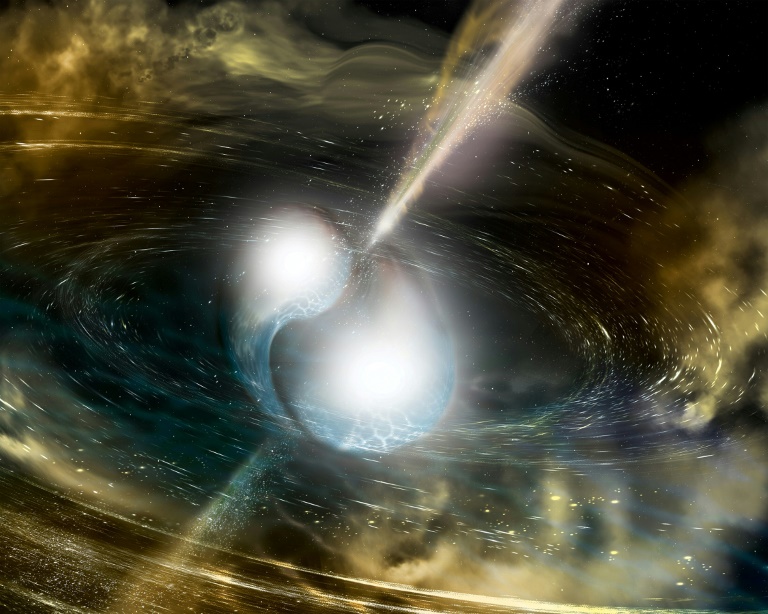Science
Astronomers Unveil Source of Fast X-ray Transients from Supernova

A significant breakthrough in astrophysics has been achieved as astronomers have identified the source of fast X-ray transients (FXTs) linked to a supernova. This discovery sheds light on the previously elusive origins of FXTs, which are intense bursts of X-rays emanating from remote galaxies. The findings, the closest FXT ever associated with a supernova, were reported by an international team led by researchers from Northwestern University and the University of Leicester in England.
Utilising a global network of telescopes, the team studied a supernova event that released a geyser of high-energy particles. This outburst, observed from a supernova’s outer layers, is believed to be responsible for generating FXTs. The research illustrates how jets of energy can create gamma-ray bursts (GRBs) when they penetrate through a massive star’s layered structure. Conversely, when these jets are confined, they produce lower-energy emissions detectable only as X-ray signals.
The observations highlight a potential link between GRB-supernovae and FXT-supernovae. In this framework, successful jets lead to GRBs, while subdued jets give rise to FXTs. Although FXTs have been detected since the 1970s, previous limitations in observational data have hindered extensive analysis. This changed with the launch of the Einstein Probe in January 2024, a collaborative effort by the Chinese Academy of Sciences, the European Space Agency, and the Max Planck Institute for Extraterrestrial Physics. The probe is equipped with advanced instruments designed specifically for X-ray observations.
Shortly after its launch, the Einstein Probe captured FXT EP 250108a, located approximately 2.8 billion light-years away in the constellation Eridanus. This proximity provided astronomers with a unique chance to observe the supernova’s progression. By monitoring signals across multiple wavelengths, the team gathered extensive data from various observatories. The FLAMINGO-2 spectrograph on the Gemini South telescope contributed near-infrared data, while the Gemini Multi-Object Spectrograph on the Gemini North telescope provided optical insights. Additional optical spectroscopy was obtained from the W.M. Keck Observatory in Hawaii, along with infrared imaging from the MMT Observatory in Arizona and data from the James Webb Space Telescope.
Upon observing EP 250108a, astronomers noted the bright aftermath of a supernova, designated SN 2025kg, or informally referred to as “the kangaroo.” This supernova exhibited a brightening phase over several weeks before gradually dimming. Analysis of its brightness and spectral data revealed that “the kangaroo” is categorized as a broad-lined Type Ic supernova, typically associated with high-energy phenomena like GRBs. However, in this instance, the evidence for a GRB was absent.
The team’s investigations indicated that EP 250108a resembles a jet-driven explosion, but its jets were unable to penetrate the outer layers of the dying star. Instead, they remained confined, resulting in the FXT emissions. To further examine the supernova, researchers employed the 4.1-meter Southern Astrophysical Research Telescope at the National Science Foundation’s Cerro Tololo Inter-American Observatory in Chile. These observations led to estimates suggesting that the progenitor star responsible for igniting EP 250108a possessed a mass between 15 to 30 times that of the Sun.
Two companion studies detailing various aspects of this event have been accepted by The Astrophysical Journal Letters. The first study, titled “The kangaroo’s first hop: the early fast cooling phase of EP250108a/SN 2025kg,” and the second, “EP 250108a/SN 2025kg: Observations of the most nearby Broad-Line Type Ic Supernova following an Einstein Probe Fast X-ray Transient,” provide deeper insights into the findings.
This groundbreaking research not only enhances our understanding of FXTs but also opens new avenues for studying the complex life cycles of massive stars and their explosive deaths. The collaborative efforts of international astronomers signal a promising future in cosmic exploration and the ongoing quest to unravel the mysteries of our universe.
-

 Science2 months ago
Science2 months agoToyoake City Proposes Daily Two-Hour Smartphone Use Limit
-

 Health2 months ago
Health2 months agoB.C. Review Reveals Urgent Need for Rare-Disease Drug Reforms
-

 Top Stories2 months ago
Top Stories2 months agoPedestrian Fatally Injured in Esquimalt Collision on August 14
-

 Technology2 months ago
Technology2 months agoDark Adventure Game “Bye Sweet Carole” Set for October Release
-

 World2 months ago
World2 months agoJimmy Lai’s Defense Challenges Charges Under National Security Law
-

 Technology2 months ago
Technology2 months agoKonami Revives Iconic Metal Gear Solid Delta Ahead of Release
-

 Technology2 months ago
Technology2 months agoSnapmaker U1 Color 3D Printer Redefines Speed and Sustainability
-

 Technology2 months ago
Technology2 months agoAION Folding Knife: Redefining EDC Design with Premium Materials
-

 Business2 months ago
Business2 months agoGordon Murray Automotive Unveils S1 LM and Le Mans GTR at Monterey
-

 Technology2 months ago
Technology2 months agoSolve Today’s Wordle Challenge: Hints and Answer for August 19
-

 Lifestyle2 months ago
Lifestyle2 months agoVictoria’s Pop-Up Shop Shines Light on B.C.’s Wolf Cull
-

 Technology2 months ago
Technology2 months agoApple Expands Self-Service Repair Program to Canada








